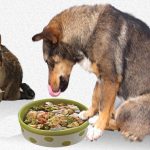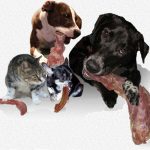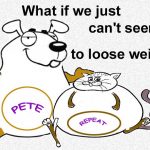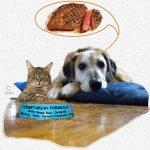What Should I Feed My Dog? Focus On Dog Food Ingredients And Quality
Ron Hines DVM PhD
This is one of my old articles. Time has passed it by. So just go to the links in the table just below for more current information. R.S.H.









**********************************************************************
Dogs have had 15,000 years to evolve from being primarily meat eaters into omnivores capable of digesting both animal and plant nutrients – just like their owner. They are no longer quite the same as their close relatives, the wolves, who are strict carnivores living on meat alone. Although dogs prefer meat-based foods, they can exist on diets high in vegetable proteins – as long as other missing nutrients and amino acids are added. Whether or not that is a good idea remains to be seen.
Good nutrition and a balanced diet are essential for your pet’s health. People often ask me what they should feed their dogs. Over the years, I have made some observations on the health of dogs fed an enormous variety of diets. When deciding what to feed your dog, focus on dog food ingredients and quality
It’s astonishing how well they do on such varied entrées. Here are some of my conclusions based on the dog food’s ingredients and quality:
Does How I Feed My Dog Matter?
What and when you feed your dog early in life will shape its preferences when it is older. It will also affect its general health. This applies to time of day, odor, texture, taste and meal temperature. Water should be available to your pet at all times, especially during heavy exercise, to prevent dehydration and overheating. Adult dogs do well on just one or two feedings a day, but puppies need to eat more frequently.
Should I Feed Canned, Dry or Homemade Food?
Some hints for homemade diets that are nutritionally balanced for your pet are given in another article in this series. Commercial dog foods are available in three forms: canned dry and semi-moist. Do not feed semi-moist dog food to your pet because of the large amounts of artificial chemical additives in them. More dry kibble is sold than any other type because of its convenience and economy. Dry foods contain about 90% dry matter and 10% water. They are a blended mixture of grains, meat and meat by-products, fats, mineral and vitamins. Canned dog food contains 68-78% water and 22-32% dry matter.
Given their choice, most dogs prefer canned or homemade diets. The aroma, flavor and palatability of dry diets do not match that of canned. (Whichever you buy, be sure the label says that the diet meets the National Research Council’s guidelines on canine nutrition and is certified by the Association of American Feed Control Officials.) Over the years, I have found that dogs fed dry diets have less tartar build up on their teeth and less gum disease surrounding the teeth. They also seem to have less obesity problems. With time, gum inflammation associated with canned diets can cause the tissues surrounding your pet’s teeth to recede, the teeth to loosen and their breath to have a bad odor. Also with time, bacteria moving through the blood stream from these infected gums might cause damage to the heart, kidneys and liver. It takes much less dry food to satisfy your pet’s appetite and need because dry food has greater caloric density – that is, it is much richer in nutrients. This is because canned food contains about 75% water. I, personally, prefer to feed my dogs canned or home-prepared food. To continue to keep your pet’s teeth clean, consider offering plenty of rawhide chews and products similar to these.
Remember that dogs (and cats) eating dry kibble, like children consuming dry food, sometimes do not drink sufficient water to prevent later dehydration. It is always preferable to add warm water to dry products before feeding them – even though you will then need to pay more attention to dental issues. Read about an alternative way to maintain the dental health of your dog here.
What about RAW AND BARF Diets?
I am not a big fan of fad diets of any kind. Cooking unlocks many nutrients in foods (but it also destroys a few). My personal feeling is that there are more risks of bacterial and viral contamination in feeding a raw diet than there are conceivable health benefits. You can always supplement your pet’s diet with additional vitamins. There is no reputable scientific evidence that raw foods are better for your pet, but we do know that cooking can make available more food energy from the meat protein your pet eats.
So, recommendations you read on the internet that suggest you feed raw food ingredients to your pet are based on unsubstantiated conviction – not science or unbiased observation. A study conducted by the Division of Nutritional Sciences, University of Illinois (the only one I know of) found no significant difference between raw diets and cooked diets in the nutrients available to cats, nor in digestibility.
What If I Feed My Pet Table Scraps?
Table scraps, given randomly, are not a balance home-cooked diet. When your pet begs at the table or primarily eats leftovers, it is unlikely to meet all its nutritional needs. The same goes for feeding a diet composed mostly of unsupplemented meats.
Feeding unsupplemented hamburger and rice mixture or table foods can cause a calcium deficiency in your pet and a secondary over-activity parathyroid gland (hyperparathyroidism). It can also cause a calcium deficiency leading to broken bones, loose teeth and arthritis. All-meat diets can also cause constipation and anal gland problems. Feeding a Liver-based diet can poison the pet with too much vitamin A. Many loving pet owners, make homemade diets contain too much protein and phosphorus but not enough calcium, vitamins, micro-minerals and fiber that all healthy pet needs.
How Much Should I Feed My Dog?
Individual dogs vary greatly in the amount of food necessary for optimal weight and health. Active breeds such as Brittany spaniels have a much higher metabolic rate than more placid breeds. Many adult dogs I see are overweight. If you can’t feel your dog’s ribs it is almost certainly overweight. If the top of its back is flat, it is overweight. Beauty and svelte is in the eyes of the beholder, so it is often hard for a loving dog owners to even notice that their dog is too plump. But If friends ever remark that your dog is fat, believe it. Growing dogs and puppies require considerably more food per pound of body weight to thrive than adults or senior pets do. Most dry dog chows give approximate feeding amounts on their labels. The following chart is an estimate of how much to feed an adult dog each day when using a name brand dry dog chow that contains 21% protein, 5% oil, 2.5% fiber and 8% ash.
What Are The Nutrient Requirements of Dogs?
There are ten essential amino acids, the building blocks of protein, that dogs cannot manufacture on their own. Studies have shown that dogs can tell when their food lacks a single amino acid and will avoid such a meal. One amino acid, taurine, is sometimes deficient in dry dog chows. Although dogs can synthesize taurine from two other amino acids, cysteine or methionine, diets composed chiefly of lamb and rice seem to prevent this process. This may be due to the action of rice bran in increasing the body’s loss of taurine through the intestine. Dogs lacking taurine are susceptible to a form of heart enlargement called dilated cardiomyopathy or DCM.
Although high fiber diets are not natural for dogs, some dietary fiber is important for gastrointestinal motility. Diets rich in dietary fiber can also help your pet lose weight. But too much fiber can prevent the absorption of vitamins and minerals and lead to diarrhea.
What Minerals Do My Dog Need?
There are twelve minerals that are essential for dogs. One of these, calcium, is essential for the formation of bone and teeth and as a signal chemical between nerve cells. Puppies that do not receive sufficient calcium have pinkish, translucent teeth a bow-legged stance and knobby painful joints. Partial bone fractures in these puppies are common. Most of these puppies were the offspring of nutritionally deprived mothers. Others received a diet that was primarily meat and bread. Meat is low in calcium and high in phosphorus. High phosphorus interferes with the absorption of the little calcium that meat contains. Older dogs on low calcium, high phosphorus diets also suffer from tooth and bone problems. A lack of vitamin D3, which is also called cholecalciferol, can contribute to this. Your body can manufacture cholecalciferol or convert vitamin D2 into vitamin D3. Your dog cannot.
Magnesium is important for muscle and nerve cell activity, as well as a portion of the mineral structure of bone and teeth. Dogs deficient in magnesium have reduced weight gain, as well as motility problems later in life.
Dogs are remarkably adaptable to a wide range of ingredients, texture, and form in terms of what they will eat. Though many dogs prefer animal-based protein, they can thrive on a supplemented vegetarian diet. Older dogs appear to require as much as fifty percent more protein to maintain their protein reserves.
How Often Should I Feed My Dog?
Dogs eat larger, less frequent meals than cats do. It is OK to feed a healthy adult dog once or twice a day. (There are some medical condition when more frequent feeding might be desirable) Puppies, however, need more frequent feedings. Most owners allow their pets to eat as much as they desire. There are dogs that can self-regulate in that situation, but there are others that will gain too much weight.
What About Food Quality?
Dog foods differ primarily in their source of protein. Generic dog foods use less expensive sources of protein. Because of this, the quality of protein in generic and house brand foods is poorer. Do not be led astray by considering only the percent protein. Percent protein tells nothing about the quality and digestibility of the product. Excluding premium, niche and specialty brands sold through pet shops, the quality of dog foods is usually reflected directly in the price you pay. I do not recommend brands of dog food that are sold only by groomers, internet suppliers, veterinarians or pet stores. These foods tend to be overpriced. More importantly, they are produced by small companies that do not have the resources to monitor the quality of their ingredients, so they may vary from batch to batch. They also tend to make very exaggerated claims about the ability of their products to cure or prevent every conceivable disease. Stay with products produced by large national or international companies that sell other products you trust. (This advice does not apply to diets that veterinarians sell to manage specific diseases) What you should feed your dog depends on the ingredients and quality.
Obtaining unbiased information regarding health benefits and health risks regarding what you feed your dog is difficult. You are not going to get it from pet food manufacturers or the “studies” they underwrite. For instance, cats are known to be much less efficient in processing the high carbohydrate content of grains-based diets than your dog is. Carbohydrates are a cheap commodity. They earn cat food manufacturers considerably more profits than a high meat diet would. As public awareness of the high carbohydrates content of commercial cat foods becomes common knowledge, major cat food manufacturers such as Nestlé Purina, Hills/Colgate-Palmolive and Mars PetCare (= Pedigree, Nutro and Royal Canin) push back. (read here & here) One can expect the same media spin for dogs.
Does My Dog Need Fiber?
Fiber in the diet is good for the overall gastrointestinal health of your pet and may help some dogs keep their weight down. The exceptions are pets with certain chronic diarrheas that are worsened by fiber or bulk.
We think that the diet of normal adult dogs should contain between 2.5 and 4.5 percent fiber. However, the fiber content of some “diet” dog foods is between nine and 10 percent. This may allow the dog to feel full without consuming too many calories for effective weight control. Diets high in fiber also help in the management of blood sugar (hyperglycemia) and the prevention of such disorders as megacolon and diabetes.
Too much fiber in your pet’s diet can interfere with the digestion of other important nutrients in the food and result in loose stools, frequent defecation, and reduced palatability of the dog food. Generally, foods low in starch content, such as wheat and oat bran and barley products, are high in fiber. Dog food ingredients high in starch, including rice and dried potatoes, and corn have less fiber.
How Should I Manage My Overweight Dog?
The simplest way to reduce overweight dogs is to feed smaller amounts on the same feeding schedule. Some dog owners offer less tasty food or allow less time to eat. Others feed several meals of bulky vegetables such as cooked carrots or cabbage to their pets. Another option is to feed one of the many low-calorie dog foods on the market. It’s also important to remember to keep your dog from sampling another pet’s food and to refrain from feeding table foods as treats. Read about that in detail here
Dogs have had 15,000 years to evolve from being primarily meat eaters into omnivores capable of digesting both animal and plant nutrients – just like their owner. They are no longer quite the same as their close relatives, the wolves, who are strict carnivores living on meat alone. Although dogs prefer meat-based foods, they can exist on diets high in vegetable proteins – as long as other missing nutrients and amino acids are added. Whether or not that is a good idea remains to be seen.
Good nutrition and a balanced diet are essential for your pet’s health. People often ask me what they should feed their dogs. Over the years, I have made some observations on the health of dogs fed an enormous variety of diets. When deciding what to feed your dog, focus on dog food ingredients and quality
It’s remarkable how well they do on such varied entrées. Here are some of my conclusions based on the dog food’s ingredients and quality:
Does How I Feed My Dog Matter?
What and when you feed your dog early in life will shape its preferences when it is older. It will also affect its general health. This applies to time of day, odor, texture, taste and meal temperature. Water should be available to your pet at all times – especially during heavy exercise to prevent dehydration and overheating. Adult dogs do well on just one or two feedings a day, but puppies need to eat more frequently.
Should I Feed Canned, Dry or Homemade Food?
Some hints for homemade diets that are nutritionally balanced for your pet are given in another article in this series. Commercial dog foods are available in three forms: canned dry and semi-moist. Do not feed semi-moist dog food to your pet because of the large amounts of artificial chemical additives in them. More dry kibble is sold than any other type because of its convenience and economy. Dry foods contain about 90% dry matter and 10% water. They are a blended mixture of grains, meat and meat by-products, fats, mineral and vitamins. Canned dog food contains 68-78% water and 22-32% dry matter.
Given their choice, most dogs prefer canned or homemade diets. The aroma, flavor and palatability of dry diets do not match that of canned. (Whichever you buy, be sure the label says that the diet meets the National Research Council’s guidelines on canine nutrition and is certified by the Association of American Feed Control Officials.) Over the years I have found that dogs fed dry diets have less tartar build up on their teeth and less gum disease surrounding the teeth. They also seem to have less obesity problems. With time, gum inflammation associated with canned diets can cause the tissues surrounding your pet’s teeth to recede, the teeth to loosen and their breath to have a bad odor. Also with time, bacteria moving through the blood stream from these infected gums might cause damage to the heart, kidneys and liver. It takes much less dry food to satisfy your pet’s appetite and need because dry food has greater caloric density – that is, it is much richer in nutrients. This is because canned food contains about 75% water. I personally prefer to feed my dogs canned or home-prepared food. To continue to keep your pet’s teeth clean, consider offering plenty of rawhide chews and products similar to these.
Remember that dogs (and cats) eating dry kibble, like children consuming dry food, sometimes do not drink sufficient water to prevent later dehydration. It is always preferable to add warm water to dry products before feeding them – even though you will then need to pay more attention to dental issues. Read about an alternative way to maintain the dental health of your dog here.
What about RAW AND BARF Diets?
I am not a big fan of fad diets of any kind. Cooking unlocks many nutrients in foods (but it also destroys a few). My personal feeling is that there are more risks of bacterial and viral contamination in feeding a raw diet than there are conceivable health benefits. You can always supplement your pet’s diet with additional vitamins. There is no reputable scientific evidence that raw foods are better for your pet, but we do know that cooking can make available more food energy from the meat protein your pet eats.
So, recommendations you read on the internet that suggest you feed raw food ingredients to your pet are based on unsubstantiated conviction – not science or unbiased observation. A study conducted by the Division of Nutritional Sciences, University of Illinois (the only one I know of) found no significant difference between raw diets and cooked diets in the nutrients available to cats, nor in digestibility.
What If I Feed My Pet Table Scraps?
Table scraps, given randomly, are not a balance home-cooked diet. When your pet begs at the table or primarily eats leftovers, it is unlikely to meet all its nutritional needs. The same goes for feeding a diet composed mostly of unsupplemented meats.
Feeding unsupplemented hamburger and rice mixture or table foods can cause a calcium deficiency in your pet and a secondary over-activity parathyroid gland (hyperparathyroidism). It can also cause a calcium deficiency leading to broken bones, loose teeth and arthritis. All-meat diets can also cause constipation and anal gland problems. Feeding a Liver-based diet can poison the pet with too much vitamin A. Many loving pet owners, make homemade diets contain too much protein and phosphorus but not enough calcium, vitamins, micro-minerals and fiber that all healthy pet needs.
How Much Should I Feed My Dog?
Individual dogs vary greatly in the amount of food necessary for optimal weight and health. Active breeds such as Brittany spaniels have a much higher metabolic rate than more placid breeds. Many adult dogs I see are overweight. If you can’t feel your dog’s ribs it is almost certainly overweight. If the top of its back is flat, it is overweight. Beauty and svelte is in the eyes of the beholder, so it is often hard for a loving dog owners to even notice that their dog is too plump. But If friends ever remark that your dog is fat, believe it. Growing dogs and puppies require considerably more food per pound body weight to thrive than adults or senior pets do. Most dry dog chows give approximate feeding amounts on their labels. The following chart is an estimate of how much to feed an adult dog each day when using a name brand dry dog chow that contains 21% protein, 5% oil, 2.5% fiber and 8% ash.
What Are The Nutrient Requirements of Dogs?
There are ten essential amino acids, the building blocks of protein, that dogs cannot manufacture on their own. Studies have shown that dogs can tell when their food lacks a single amino acid and will avoid such a meal. One amino acid, taurine, is sometimes deficient in dry dog chows. Although dogs can synthesize taurine from two other amino acids, cysteine or methionine, diets composed chiefly of lamb and rice seem to prevent this process. This may be due to the action of rice bran in increasing the body’s loss of taurine through the intestine. Dogs lacking taurine are susceptible to a form of heart enlargement called dilated cardiomyopathy or DCM.
Although high fiber diets are not natural for dogs, some dietary fiber is important for gastrointestinal motility. Diets rich in dietary fiber can also help your pet lose weight. But too much fiber can prevent the absorption of vitamins and minerals and lead to diarrhea.
What Minerals Do My Dog Need?
There are twelve minerals that are essential for dogs. One of these, calcium, is essential for the formation of bone and teeth and as a signal chemical between nerve cells. Puppies that do not receive sufficient calcium have pinkish, translucent teeth a bow-legged stance and knobby painful joints. Partial bone fractures in these puppies are common. Most of these puppies were the offspring of nutritionally deprived mothers. Others received a diet that was primarily meat and bread. Meat is low in calcium and high in phosphorus. High phosphorus interferes with the absorption of the little calcium that meat contains. Older dogs on low calcium high phosphorus diets also suffer from tooth and bone problems. A lack of vitamin D3 which is also called cholecalciferol can contribute to this. Your body can manufacture cholecalciferol or convert vitamin D2 into vitamin D3. Your dog cannot.
Magnesium is important for muscle and nerve cell activity as well as a portion of the mineral structure of bone and teeth. Dogs deficient in magnesium have reduced weight gain, as well as motility problems later in life.
Dogs are remarkably adaptable to a wide range of ingredients, texture, and form in terms of what they will eat. Though many dogs prefer animal-based protein, they can thrive on a supplemented vegetarian diet. Older dogs appear to require as much as fifty percent more protein to maintain their protein reserves.
How Often Should I Feed My Dog?
Dogs eat larger, less frequent meals than cats do. It is OK to feed a healthy adult dog once or twice a day. (There are some medical condition when more frequent feeding might be desirable) Puppies, however, need more frequent feedings. Most owners allow their pets to eat as much as they desire. There are dogs that can self-regulate in that situation, but there are others that will gain too much weight.
What About Food Quality?
Dog foods differ primarily in their source of protein. Generic dog foods use less expensive sources of protein. Because of this, the quality of protein in generic and house brand foods is poorer. Do not be led astray by considering only the percent protein. Percent protein tells nothing about the quality and digestibility of the product. Excluding premium, niche and specialty brands sold through pet shops, the quality of dog foods is usually reflected directly in the price you pay. I do not recommend brands of dog food that are sold only by groomers, internet suppliers, veterinarians or pet stores. These foods tend to be overpriced. More importantly, they are produced by small companies that do not have the resources to monitor the quality of their ingredients, so they may vary from batch to batch. They also tend to make very exaggerated claims about the ability of their products to cure or prevent every conceivable disease. Stay with products produced by large national or international companies that sell other products you trust. (This advice does not apply to diets that veterinarians sell to manage specific diseases) What you should feed your dog depends on the ingredients and quality.
Obtaining unbiased information regarding health benefits and health risks regarding what you feed your dog is difficult. You are not going to get it from pet food manufacturers or the “studies” they underwrite. For instance, cats are known to be much less efficient in processing the high carbohydrate content of grains-based diets than your dog is. Carbohydrates are a cheap commodity. They earn cat food manufacturers considerably more profits than a high meat diet would. As public awareness of the high carbohydrates content of commercial cat foods becomes common knowledge, major cat food manufacturers such as Nestlé Purina, Hills/Colgate-Palmolive and Mars PetCare (= Pedigree, Nutro and Royal Canin) push back. (read here & here) One can expect the same media spin for dogs.
Does My Dog Need Fiber?
Fiber in the diet is good for the overall gastrointestinal health of your pet and may help some dogs keep their weight down. The exceptions are pets with certain chronic diarrheas that are worsened by fiber or bulk.
We think that the diet of normal adult dogs should contain between 2.5 and 4.5 percent fiber. However, the fiber content of some “diet” dog foods is between nine and 10 percent. This may allow the dog to feel full without consuming too many calories for effective weight control. Diets high in fiber also help in the management of blood sugar (hyperglycemia) and the prevention of such disorders as megacolon and diabetes.
Too much fiber in your pet’s diet can interfere with the digestion of other important nutrients in the food and result in loose stools, frequent defecation, and reduced palatability of the dog food. Generally, foods low in starch content, such as wheat and oat bran and barley products, are high in fiber. Dog food ingredients high in starch, including rice and dried potatoes, and corn have less fiber.
How Should I Manage My Overweight Dog?
The simplest way to reduce overweight dogs is to feed smaller amounts on the same feeding schedule. Some dog owners offer less tasty food or allow less time to eat. Others feed several meals of bulky vegetables such as cooked carrots or cabbage to their pets. Another option is to feed one of the many low-calorie dog foods on the market. It’s also important to remember to keep your dog from sampling another pet’s food and to refrain from feeding table foods as treats. Read about that in detail here
About Your Pets’ Energy Needs:
Normal active adult dogs that weigh about thirty-five pounds need to eat about 1000 calories (= Cal large or nutritional calories) a day. In most dog foods, these calories are furnished in the form of cereals, legumes and other plant products. Sick or injured dogs can require double this number of calories. Young puppies need about twice as many calories per pound of body weight as adult dogs of the same breed. The best time to begin feeding a puppy, dog food is at four weeks of age. Mother dogs that are producing milk need as much as four times the calories of non-nursing dogs. Older and lazy dogs will do fine on twenty percent fewer calories.
What Vitamins Do My Pet Need?
If you feed a quality dog food, there is absolutely no need to give your pet a vitamin supplement unless it is suffering from some disease that prevents it from absorbing these vitamins normally. Vitamins are organic compounds that take part in a wide range of metabolic activities. Dogs require vitamins in their food at low concentrations. Vitamin deficiencies were first noticed in dogs some 85 years ago. They can lead to widely ranging clinical abnormalities. Some vitamins, such as vitamin A, are not only essential in small doses, but also toxic in large amounts. Vitamin A is important for good vision, and skin and mucous membrane structure. A lack of sufficient vitamin A in the dog’s diet leads to eye and skin problems and increased susceptibility to infection. I mentioned vitamin D3 earlier. Vitamin D3 is also required for strong bones and teeth. Inadequate amounts of Vitamin D3 will rickets if the dog is still growing. In adult dogs it causes porous weak bones (osteoporosis). Many human vitamin preparations once contained vitamin D2 which does not appear to help dogs. Vitamin E protects the body against damage due to oxidation and free radials. In addition to prematurely aging your pet, lack of vitamin E can result in poor coat condition.
Comment from Australia:
“Dear Dr. Hines, I love your website and the information you supply me with. However, the article about what to feed a dog started with an inaccurate fact. Wolves are not strict carnivores. They are mostly meat eaters, but are opportunistic as well, eating berries, grasshoppers, and plants, mostly when game is scarce. Wolves actually need those carbohydrates to stay healthy. Many zoos learned this the hard way when their wolves became weak with vitamin deficiencies. More research showed that though meat is the primary diet, the Canin Lupus also eats veggies.”
Hi Mate, I chanced upon your website and a very good one it is. One small observation regarding the feeding of dogs; I have had many dogs, and frankly I cannot go past bones. I have no idea what happens over your way, but here we have “butcher shops” and the butcher always sells bones. Dogs thrive on them; however, they also need a diet of leftovers – rice/potatoes/vegetables to keep them tip-top. It’s just a little feedback. Canned food is HORRIBLE (it makes them fart) and dry food, well sorry, It’s just not on. My shepherd is a cracker, and he lives off exactly that – bones and leftovers; great teeth and coat. Happy chappy! All the best
You are on the Vetspace animal health website
Visiting the products that you see displayed on this website help pay the cost of keeping these articles on the Internet.

